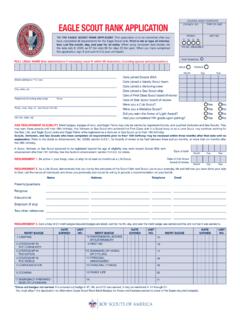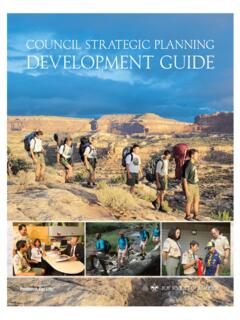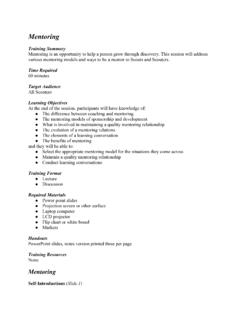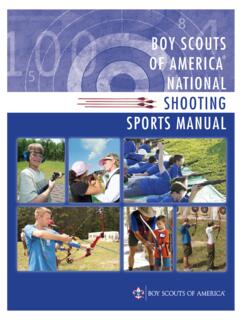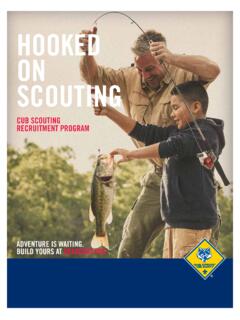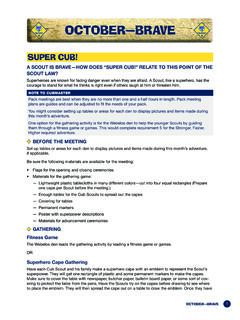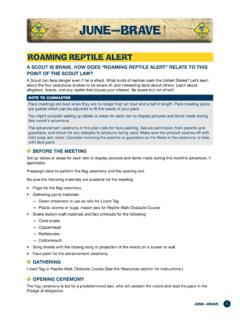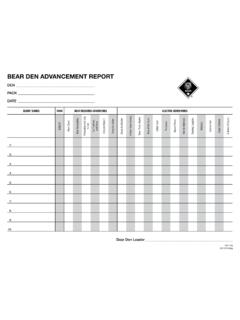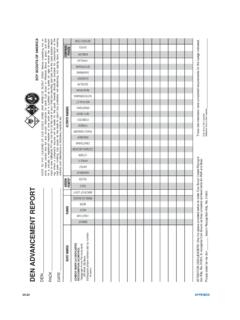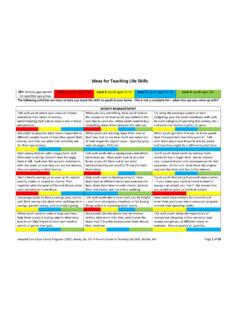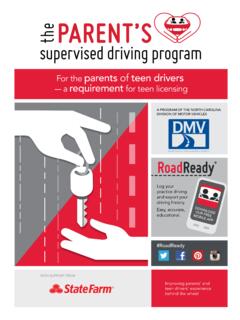Transcription of DEAR PARENT - Boy Scouts of America
1 2 A PARENT s GuideDEAR PARENTThe Boy Scouts of America is pleased to provide this booklet it might be the most important information you, your child, and your family will ever read. Understanding these pages could prevent your child or another child from being abused or may empower you to stop abuse as soon as possible and seek the necessary help. Child abuse is something we would rather not talk about, or even think about, but we must. Every offender benefits from our ignorance. If we fail to do everything we can to keep our children safe, the consequences can be devastating, even deadly. This booklet cannot address all threats to personal safety your child may experience in and out of Scouting, but it will teach you how to identify and prevent numerous forms of abuse. It contains exercises, based on a set of personal safety rules, that will empower your child to better recognize, respond to, and report abuse.
2 Go through the exercises together. Your child is that important. In fact, all children are that important. Youth Protection Begins With This BookletThis booklet is divided into two sections. The first section contains information for parents about child abuse and some tips for talking with your child about child abuse. The second section A PARENT s guide 3contains exercises for you to share with your child. Research shows that children whose parents talk to them about preventing abuse are better able to protect themselves and are more likely to tell if they are abused. As your child grows, look for opportunities to continue a dialogue about personal safety awareness. Open communication gives children the reassurance that no matter how frightening something may be, their parents are there to help. WHAT EVERY PARENT SHOULD KNOWC hildren can experience abuse in many ways: neglect, physical abuse, sexual abuse, or emotional abuse.
3 Often a child who is abused in one way is abused in multiple ways. When we protect a child from one form of abuse, such as physical abuse, we are often protecting the child from additional forms of abuse. NeglectNeglect often involves depriving a child of food, clothing, shelter, medical care, or other necessities of life . Neglect can also involve exposing a child to harmful substances or materials such as drugs, alcohol, or pornography, or to harmful practices such as violent behavior. A number of clues suggest that a child might be neglected. The child who frequently comes to meetings with body odor, the child who is frequently unkempt, the child who is living in a dangerous environment, and the child with an obvious medical need that goes unattended all are exhibiting signs of potential neglect. So is the child who is always hungry or who hoards or steals food, the child who is seldom dressed appropriately for the weather, and the child who regularly talks of seeing a PARENT drunk or bruised from being hit.
4 parents who cannot provide for children as a result of poverty are not committing neglect. Neglect is a deliberate act or inaction that has a physical and emotional impact on a child and, in some instances, can cost a child his A PARENT s GuideAny time a child exhibits a need or condition that a reasonable PARENT would attend to especially when the failure to provide the need impairs the child s physical or emotional well-being the child is likely being Abuse Physical abuse is the deliberate injury of a child by a person responsible for the child s abuse injuries can include bruises, broken bones, burns, and abrasions. Children experience minor injuries as a normal part of childhood, usually in places such as the shins, knees, and elbows. When injuries are found in the soft-tissue areas on the abdomen or back, or when they do not seem to be typical childhood injuries, it is possible that the child has been abused.
5 Blows to the stomach may result in abdominal bruises, even if there is not a visible mark. When a child complains of pain or indicates he was punched in the stomach, such a complaint should be taken seriously, given the possibility of internal injury. The following signs are commonly associated with abuse but are not absolutes. Injuries the child or PARENT cannot adequately explain Injuries on a child who has been absent Complaints of soreness when moving Fear of going home with or to parentsTalking to Youth About Suspicious InjuriesIt is appropriate to ask a child about suspicious injuries. If the child tells of abuse or gives an answer that does not make sense given the location or extent of injuries, you should document this statement and immediately contact the local law enforcement agency or state department of children and family more information about reporting requirements, call 911 or see the Child Welfare Information Gateway website at for your state hotline number.
6 A PARENT s guide 5 Sexual AbuseWhen an adult or older youth uses his or her authority to involve a child in sexual activity, it is child sexual abuse. Sexual abuse includes any activity performed for the sexual satisfaction of the offender. Children can be at risk of sexual abuse anywhere: at home; at a neighbor s house; at school, field trips, and public events; and in common misconception about sexual abuse is that children are most likely to be abused by strangers. In fact, a sex offender is usually someone the child knows and trusts. Sex offenders are most often male, but females are the offenders in about one-fifth of the incidents involving boys under the age of 14. Sexual Abuse by AdultsAdults who abuse children may manipulate, bribe, coerce, threaten, or force a child into feeling like a partner in the sexual activity.
7 However, they most often use a multistep grooming process that focuses on the child s needs and possibly on the child s parents as well. The sex offender might offer the parents free babysitting services, for example, or make friends with them to gain enough trust to be alone with the , the grooming process with the child begins with seemingly harmless touching, such as hugging, massages, exposure, and questionable touching. The sex offender usually seeks a child who craves affection or attention and makes that child feel special by spending a lot of time with him or her and giving gifts and money. But all young children are vulnerable to sexual abuse because of their innocence and total trust in and dependence upon adults. When the sex offender senses that the child has been sufficiently conditioned to physical contact and has an emotional bond, the physical contact becomes more intrusive.
8 The offender may prey on the child s emerging curiosity about sexuality and may carry on A red flag may be a person who does not take BSA Youth Protection policies seriously or who exhibits a nonchalant at-titude when questioned about an unusual situation. 6 A PARENT s Guideunder the guise of sex education or playing inappropriate games. It may involve violating rules, drinking alcohol, smoking cigarettes all to create a special relationship. Most children do not understand that what is happening is sexual or is wrong until it is too offenders are clever enough to manipulate the child into believing that he or she is equally to blame or will not be believed if they tell. Many children feel trapped and are afraid to tell. Sexual Abuse by Other YouthIt is also possible for a child of the same age to abuse another through force or manipulation.
9 About a third of sexual abuse occurs at the hands of other children, including older youth and youth in positions to manipulate through bullying behavior using their size or knowledge difference. Any peer activity, such as a club initiation, in which sexual activity is included is a form of sexual abuse. Overnight activities pose a greater risk of abuse. Personal safety awareness rules should be reviewed before these activities. Adults who learn or discover that youth-on-youth abuse has occurred must take immediate steps to stop AbuseA child suffers from emotional abuse when continually ridiculed, blamed, humiliated, or compared unfavorably with others. Emotional abuse damages the child s self-esteem. Studies find that emotional abuse is just as harmful, if not more harmful, than other forms of maltreatment.
10 It can lead to developmental problems, speech delays, depression, anxiety, and conditions such as low empathy and difficulty with peers. Emotional abuse can occur when a PARENT completely ignores or rejects or regularly threatens to beat a child or when a child struggles to meet a PARENT s unreasonable expectations in academics, athletics, or other areas. Emotional abuse can also result if an adult or older youth provides a child with alcohol, drugs, pornography, or other harmful substances or materials. Spiritual AbuseAn often-overlooked form of child maltreatment is spiritual abuse the incorporation of religion into the abuse of a child. Some studies suggest that sex offenders are particularly attracted to faith A PARENT s guide 7communities because they find clergy and other faith leaders to be overly trusting.
